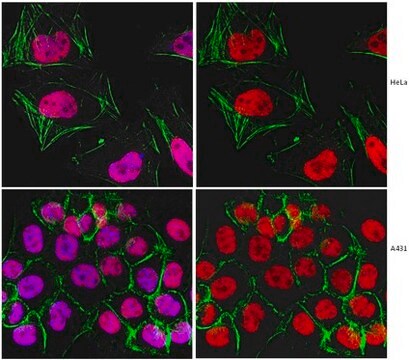The concentration of this antibody is reported on a lot specific basis. The product specification range is 6 - 12 mg/mL. A brief review of the lot history shows a typical range of 8 - 10 mg/mL. Please see the link below to review a sample or lot specific certificate:
https://www.sigmaaldrich.com/product/sigma/p2921#product-documentation
P2921
Monoclonal Anti-Protein A antibody produced in mouse
clone SPA-27, ascites fluid
Sinónimos:
Monoclonal Anti-Protein A
About This Item
Productos recomendados
origen biológico
mouse
Nivel de calidad
conjugado
unconjugated
forma del anticuerpo
ascites fluid
tipo de anticuerpo
primary antibodies
clon
SPA-27, monoclonal
contiene
15 mM sodium azide
técnicas
immunocytochemistry: suitable
indirect ELISA: 1:20,000
western blot: suitable
isotipo
IgG1
Condiciones de envío
dry ice
temp. de almacenamiento
−20°C
modificación del objetivo postraduccional
unmodified
¿Está buscando productos similares? Visita Guía de comparación de productos
Descripción general
Especificidad
Inmunógeno
Aplicación
Acciones bioquímicas o fisiológicas
Forma física
Cláusula de descargo de responsabilidad
¿No encuentra el producto adecuado?
Pruebe nuestro Herramienta de selección de productos.
Código de clase de almacenamiento
10 - Combustible liquids
Clase de riesgo para el agua (WGK)
nwg
Punto de inflamabilidad (°F)
Not applicable
Punto de inflamabilidad (°C)
Not applicable
Elija entre una de las versiones más recientes:
Certificados de análisis (COA)
¿No ve la versión correcta?
Si necesita una versión concreta, puede buscar un certificado específico por el número de lote.
¿Ya tiene este producto?
Encuentre la documentación para los productos que ha comprado recientemente en la Biblioteca de documentos.
-
I would like to know the concentration (mg/mL) of the anti-proA antibody. Thanks!
1 answer-
Helpful?
-
Active Filters
Nuestro equipo de científicos tiene experiencia en todas las áreas de investigación: Ciencias de la vida, Ciencia de los materiales, Síntesis química, Cromatografía, Analítica y muchas otras.
Póngase en contacto con el Servicio técnico








